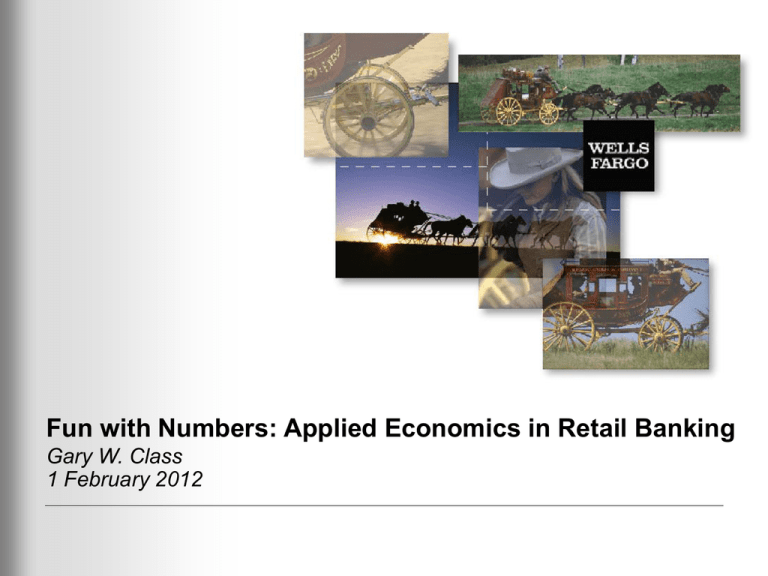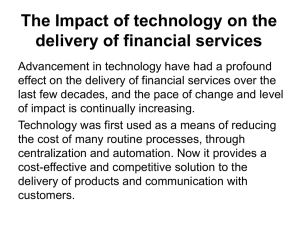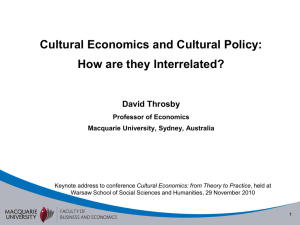GaryClassWellsFargoAnalyticsInRetailBanking30Jan12
advertisement

Fun with Numbers: Applied Economics in Retail Banking Gary W. Class 1 February 2012 Who is Wells Fargo? Wells Fargo & Company is a diversified financial services company providing banking, insurance, investments, mortgage, and consumer and commercial finance through more than 9,000 stores and 12,000 ATMs and the Internet across North America and internationally. – One in three households in America does business with Wells Fargo. – Wells Fargo has $1.3 trillion in assets and more than 270,000 team members across our 80+ businesses. – We first in market value of our stock among our U.S. peers as of December 31st, 2011. Our vision: “We want to satisfy all our customers’ financial needs and help them succeed financially.” 2 Who is Gary Class & why should I listen to him? ACADEMIC: B.A. cum laude, University of Pennsylvania, 1982 Major: English & Economics M.B.A. Haas School, University of California, Berkeley, 1988 Concentration: Finance PROFESSIONAL: Senior Vice President Internet Strategy Wells Fargo Bank COMMUNITY: Chair, Parks & Recreation Commission, City of Albany, California 3 Who is Gary Class and why should I listen to him ? Developed at Wells Fargo: Branch Teller & ATM Site Planning Models Staffing & Scheduling Tools Online Banking Customer Data Warehouse Customer Behavior Predictive Models Customer Behavior Across Multiple Channels Analytics to make Anytime, Anywhere Banking Happen 4 Retail Banking Defined Retail Financial Services involves families and small businesses. Organizations which can participate directly in securities markets (businesses, governments, institutions) are by definition excluded and are the province of “wholesale or investment banking.” 5 Functions of Retail Financial Services Payments. The financial system must provide a mechanism for the transfer of money and payments for goods and services. Risk Management. mechanisms to mitigate the financial risks faced by consumers, notably via insurance products. Borrowing—advancing funds from the future to today. The function of household credit encompasses short-term unsecured borrowing, longer-term unsecured borrowing and secured borrowing. Saving / Investing—advancing funds from today until a later date. These products vary based on the intended time horizon, level and type of risk borne by the investor, tax treatment, and other factors. 6 Functions of Retail Financial Services …are facilitated by Quantitative Models that leverage information technology Payments. Extensive fraud risk prevention & mitigation models, most notably “Falcon” from FICO. Borrowing—advancing funds from the future to today. Centralized Credit Bureau data & Credit Risk Score-cards (e.g. the “FICO Score”). Saving / Investing—advancing funds from today until a later date. Application of Modern Portfolio Management (mean-variance analysis and the Fama-French extension thereto). Risk Management. A critical aspect of the traditional deposit banking system is “delegated monitoring” where banks can gain incremental insight into a customers’ credit risk by carefully evaluating the customers’ usage of deposit accounts. 7 Applied Economics in Practice A. Identify a pressing Strategic Issue and where the issue is amenable to a systematic solution B. Identify the appropriate analytical approach (i.e. Model) to address the Issue C. Specify, estimate & validate the Model D. Build Decision Support Tools based on the Model E. Distribute the Decision Support Tools for use “in the field” Key External Resources to Leverage for (B ) & (C) Academia (D) & (E) Consulting Firms & Technology Vendors 8 Applied Economics in Practice: Experimental Design PROBLEM: Unlike in the natural sciences, there really are no repeatable, controlled experiments in the social sciences – including economics. In the business world, customer behavior is influenced by a host of factors exogenous to the direct relationship of the firm with the customer: macro-economic factors, competitive dynamics, the “social & cultural” calendar. SOLUTION: One best practice is to leverage “natural experiments” of policy changes or product introduction & use behavioral models as “controls” for confounding factors. Jim Manzi, founder of Applied Predictive Technologies Dennis Campbell @ Harvard University 9 Behavioral Model: Customer Attrition PROBLEM: Customers defect from the bank, taking their current & potential revenue stream with them. SOLUTION: Develop a model to identify the factors associated with retention and assess the risk that a customer will “attrite” (i.e. close all of their accounts with the bank) in the forthcoming six months. APPLICATION: Tactical = Intervention & Outreach Strategic = Motivates the development of products & services that promote customer satisfaction & thereby maximize the “switching cost” for the customer to defect to another bank. 10 Customer Attrition Model : Key Factors Relationship with the Bank: What accounts do I have and how long have I had them? Product Holding Set of products held with the bank Bank Tenure length of relationship Checking Account Activity: How actively am I using my checking account? Checking Account Balance …intervals, a proxy for “primary bank relationship” Service Channel Behavior: How do I like to do my banking? Channel Activity …identifies willingness of customers to transact outside of branches Online Activity Segments …based on “functionality” and frequency of usage Demographics & Location: Who am I & where do I live? Customer Type Geography Retail or Mixed (i.e. owns business accounts, also) Based on customers’ residence, strength of Branch & ATM network 11 Logistic Regression Econometric Model Objective: Score each customer based on the likelihood to discontinue banking relationship with Wells Fargo. Method: Perform univariate analysis and develop segmentation on selected customer attributes. Apply logistic procedure to estimated a binary choice model for whether or not “attrited” Yes Attrited by 6 month? No e Zi P( Attrited )i 1 e Zi –Where Pi is the attrition probability for customer i. – is the intercept parameter. – Zi is a vector of explanatory or independent variables for customer i. 12 Model Performance Diagnostics There is a well-defined methodology to assess the performance of logistic regression models. I. Classification Table Over-arching consideration is the ability of the model to predict the behavior of interest (in this case, customer attrition) in the population. The framework for evaluation is a “truth table” originally developed in the pharmaceutical domain. Accuracy is a key performance statistic -- the higher the better. Obviously, no model is perfect. One goal is to balance the occurrence of “false positives” with that of “false negatives”. This is addressed by the performance metrics of “sensitivity” and “specificity”; the key consideration is that the two values are balanced. 13 13 Model Performance Diagnostics I. Classification Table At a specific Probability Level Pcutoff , customers can be classified as ‘Attrition =1’ or ‘Retention =1’ and can be compared with the actual values whether the customer is attrited or retained. Predicted Actual Attrition=1 Attrition=0 (Retention) Attrited True Positive False Negative Retained False Positive True Negative Predicted Predicted Positive Negative Actual Positive Actual Negative Accuracy: (true positives and negatives) / (total class) Error Rate: (false positives and negatives) / (total class) Sensitivity: (true positives) / (total actual positives) Specificity: (true negatives) / (total actual negatives) 14 14 Model Performance Diagnostics II. Dispersion (Gains Chart) A key performance consideration is the ability of the model to discriminate the behavior of interest (in this case, customer attrition) and separate those likely to exhibit the behavior in the background population from those who are not. A popular way to visualize this is the Gains Chart which sorts the population into deciles and reports the ability of the model to identify the behavior of interest. III. Stability How well does the model deal with new sets of input data? Is the model stable over time? One method is to compare the Gains Chart of Forecast Validation dataset with the Gains Chart for the Estimation dataset. 15 15 Model Performance Diagnostics: Gains Chart Customer Attrition, Predicted vs. Actual Model Score “Ventiles” grouped into Likelihood-to-Attrite Segments Predicted HIGH MODERATE Actual LOW VERY LOW VERY HIGH 1 2 3 4 5 6 7 8 9 10 11 12 13 14 15 16 17 18 19 20 Ventiles 16 Applied Economics in Practice Case Studies: Customer Satisfaction Measurement: Linkage of Behavioral & Attitudinal Data Branch & ATM Location Site Selection Operations: Branch Teller Staffing & Scheduling Database Marketing: Harvesting the proliferation of internet data to improve leads for Branch Bankers 17 Linkage of Behavioral Data & Attitudinal Data: Goals The overall goal is to identify the incremental ability of customer attitudes, as measured by market research surveys, to enhance the models developed from Behavioral Data. First, we need to identify the salient question* in the customer satisfaction survey to use in the analysis. Next, we need to isolate the extent to which Customer Attitudes measured by the survey are actually related to future Customer Behaviors**. *via Factor Analysis, a statistical data reduction technique used to explain variability among observed random variables in terms of fewer unobserved random variables call “factors”. The observed variables are modeled as linear combinations of the factors, plus “error” terms. ** Vikas Mittal & Wagner Kamakura “Satisfaction, Repurchase Intent and Repurchase Behavior: Investigating the Moderating Effects of Customer Characteristics”, Journal of Marketing Research, Feb. 2001. 18 Attitudinal Data from Customer Satisfaction Survey A representative sample of Customers were asked, on a monthly basis, via email: Q1: How satisfied are you with Wells Fargo? Five point scale, where 1=Not Satisfied and 5=Extremely Satisfied 19 Linkage of Behavioral Data & Attitudinal Data: Findings Actual Customer Retention and self-reported Customer Satisfaction are higher where the Predicted Risk of Customer Attrition is lower… Mean Response to Q1: How Satisfied are you with Wells Fargo? Actual Customer Retention % 4.37 4.23 4.13 4.10 3.78 Very High High Moderate Low Very Low Predicted Risk of Customer Attrition 20 Applied Economics in Practice Case Studies: Customer Satisfaction Measurement: Linkage of Behavioral & Attitudinal Data Branch & ATM Location Site Selection Operations: Branch Teller Staffing & Scheduling Database Marketing: Harvesting the proliferation of internet data to improve leads for Branch Bankers 21 Wells Fargo 4th & Brannan Branch in San Francisco is co-located with a Starbucks 22 Branch & ATM Location Site Selection PROBLEM: What is the optimal distribution network (branches, ATMs, etc.) to cultivate existing customers & acquire new ones? SOLUTION: Financial Modeling Economics of the discreet bank branch location, focused on customer “patronage” Strategic Marketing What markets to serve, what street-corners to be on & what customers will visit the location? Real Estate What is the marketplace value of this unique location? Avijit Ghosh @ University of Illinois 23 Branch & ATM Location Site Selection PROBLEM: How can we dimension household banking behavioral “spatially” SOLUTION: Develop & describe customer branch & ATM data as a “visitation matrix”. This allowed assignment of customers to individual branch locations via “patronage” and the delineation of “empirical trade areas” for individual branches allowing a precise estimation of local product demand. 24 Customer Behavior & Branch Empirical Trade Area 25 ATM Locations: How do they provide value to Wells Fargo? the incremental customer satisfaction stemming from convenient cash access points. the fee revenue that WFC earns when other banks’ customers pay to use WFC ATMs. 26 ATM Locations: Identification of Demand “Clump Analysis” Provides a Visual Indication of Unmet demand for ATM Withdrawals # # # ## # # # # # # # Ú Ê Ú Ê # # # Ú Ê # ## ## # # # # # ## # # # Ú Ê # # # # # ## # # # # # # # # ## # # # # # Ú Ê# ## Ú Ê Ú ÊÊ Ú # # Ú Ê Ú Ê Ú Ê ### # # ## # # # # # # Ú Ê # # # # # # Ú Ê # ## # ## # # # # # # Ú Ê # Ú Ê # Ú Ê # ## # # # # # # # # # # # # # Ú Ê # # # # # # # Ú Ê # # # # ### # ## # # # # # # # ## # # # # # Ú Ê# # # # # # ## Non-WFC ATM transactions illustrate concentrations of WF customer activity and commerce. # # ## Ú Ê ## # Ú Ê# # # # Ú Ê Ú Ê Ú# Ê # # # # ## ## # # # Ú Ê Ú ÊÊ Ú # # # # # ## # # Ú Ê # # # # # # # ## # # # # Ú Ê # # Ú Ê Ú Ê # # # ## # Ú Ê# # # # # # # # # # # ## # Ú Ê# # ## # # # # Ú Ê # # # # # # # Ú Ê # # # # # Ú Ê ## # Custo mers at Competito r Sites # 100 - 233 sales # 234 - 488 sales 489 - 1532 sales # Comp any S to res 13 - 12819 sales Ú Ê 12820 - 26197 sales Ú Ê 26198 - 68882 sales 27 Applied Economics in Practice Case Studies: Customer Satisfaction Measurement: Linkage of Behavioral & Attitudinal Data Branch & ATM Location Site Selection Operations: Branch Teller Staffing & Scheduling Database Marketing: Harvesting the proliferation of internet data to improve leads for Branch Bankers 28 Operations: Branch Teller Staffing & Scheduling PROBLEM: Mis-match between the availability of tellers and customer demand for teller services. This is a “dead-weight loss” as idle tellers waste the bank’s resources and waiting customers waste customers’ patience. Direct Cost of Teller Time Indirect Benefit of Customer Retention via Quality Customer Service 29 Operations: Branch Teller Staffing & Scheduling SOLUTION: Forecast the customer demand for teller services for each branch each day for each half-hour using historical data. Leverage queue-ing models to determine the level of teller staffing required to meet the forecast demand, with acceptable customer wait times. Develop software for branch managers to “drag & drop” branch employees on their roster into a schedule sufficient to meet the forecast demand and minimize customer wait time. Ali Kiran founder of KCG Consulting 30 Staffing & Scheduling Model Components Forecasting: start with forecasting the three building blocks: * arrival rates, * service time and * customers' (im)patience, combining the first two to create forecast of the offered-load (or workload). Staffing: Identify the costs constraints acceptable level of service; then apply queue-ing models, subject to these constraints, in order to design half-hourly staffing levels. Shifts: Integer programs, or combinatorial optimization, is then used to aggregate hourly demand into shifts. The output is a shift-schedule, specifying how many agents should available to occupy each shift Rostering: Out of the body of workers, who should come to work and when? Source: Avi Mandelbaum, “Service Engineering: Data-Based Science & Teaching in support of Service Management. Technion, Haifa, Israel, 2006. 31 Queue-ing Models: Erlang-A The most widely adopted methodology for staffing models is the algorithm developed by Erlang, which require the identification of four key parameters. Source: Avi Mandelbaum, “Service Engineering: Data-Based Science & Teaching in support of Service Management. Technion, Haifa, Israel, 2006. 32 Branch Teller Staffing: Impatience & Abandonment To dimension “abandonment”, an R&D effort included experimentation with software algorithm that converts video to anonymous branch visitor tracking data in real-time Ralph Crabtree & Iain Currie, founders of Brickstream 33 Applied Economics in Practice Case Studies: Customer Satisfaction Measurement: Linkage of Behavioral & Attitudinal Data Branch & ATM Location Site Selection Operations: Branch Teller Staffing & Scheduling Database Marketing: Harvesting the proliferation of internet data to improve leads for Branch Bankers 34 Database Marketing: Harvesting the proliferation of internet data to improve leads for Branch Bankers BACKGROUND: In the 1990s, the focus was on leveraging customer profile and account activity to develop models to predict customers’ likelihood to purchase another product and responsiveness to direct marketing. PROBLEM: The deployment of internet banking applications generated a humongous amount of customer interaction data -- how could we make sense of it & use it to identify leads for branch bankers? SOLUTION: Leverage Data warehousing technology to join Customer Profiles, Model scores with granular “secure banking application” & “public site” navigation. Steve Krause, founder of Personify Dirk van den Poel @ Ghent University 35 Take the customers’ web browsing & online banking activity …find the customers whose behavior indicates a sales lead and distribute the leads to bankers in the branch Peter Heffring, founder of Ceres Marketing Systems 36 “Drowning in Data” PROBLEM: The emergence of the internet has contributed to a proliferation of very complex data ripe for analysis * Structured Data (Administrative & Accounting) * Semi-Structured Data (system logs & weblogs) * Unstructured Data (Text, Speech, Image) 37 “Drowning in Data”, a partial solution In order for the bank to leverage & act upon semi- or unstructured data, it is convenient to transform it into relational data by: Customer-ization = explicitly linking the activity to a known customer Session-ization = creating logical groupings of the stream of interactions by user_agent & time_stamp Note: a special case of session-ization are banker-to-customer interactions where the data is modeled to approximate the customer’s view of the interaction, i.e. a “sojourn”. This approach yields cross-sectional, longitudinal time-series data by unique customer opening the door to the next generation of quantitative methods in applied economics, notably Behavioral Economics. 38 What’s Hot: The emergence of Behavioral Economics Behavioral Economics integrates economics and psychology The discipline focuses on: – 1. Identifying the ways in which behavior differs from the traditional model of economics – 2. Showing how this behavior matters in economic contexts It seeks to explain why people don’t always make rational decisions 39 What is Behavioral Finance? Leverages Behavioral Economics …the introduction of Psychological methods in Laboratory Experiments of Decision Making and increased awareness of “cognitive bias” that challenges the “rational decision maker” of neo-classical economics Daniel Kahneman and Amos Tversky It is a branch of Household Finance Economics How do individuals / families make financial decisions as compared to Institutions? A key insight that Household Finance decisions are innately more complex than those in Corporate Finance A great overview was presented in John Y. Campbell’s presidential address to the American Finance Association on January 7, 2006. 40 What’s Hot in Marketing Science: PROBLEM: In “contractual” settings like Cable providers or retail banks, customers hold a portfolio of services in a very complex way. POTENTIAL SOLUTION: Leverage “Dynamic Hidden Markov Model” to identify the latent relationship step through which customers “evolve”, allowing a deeper understanding of “cross-sell” & “attrition”. David Schweidel @ University of Wisconsin PROBLEM: The social relationships that customers of service providers have with one another impact their relationship with the firm. POTENTIAL SOLUTION: The author leveraged data on communication among one million customers of a cellular company to create a large-scale social system composed of customers' individual social networks. Analytical technique: Graph Theory Barak Libai @ Tel Aviv University PROBLEM: Identifying which anonymous prospects on a website are likely to progress to “conversion” in the “shopping cart”. POTENTIAL SOLUTION: Apply advanced statistical techniques to capture the “evolving visit behavior in click-stream data”. Pete Fader @ U. of Pennsylvania & Wendy Moe @ U. of Maryland 41 What’s Next: Combining contextual and analytical approaches provide a more complete picture of how customers interact with the firm BEHAVIORAL ANALYTICS Ethnography • Real people • Real behavior • Everyday situations • Observation over time • Narrative Stories • Numeric Patterns • Patterns / themes • Statistical Significance • Experiential relevance • Ability to model and predict Both approaches privilege observation and understanding what people actually do and look for opportunities to fix, improve and innovate. Robin Beers, founder of Business is Human Wagner Kamakura @ Duke University 42 Applied Economics in Retail Banking: Looking Forward John Y. Campbell @ Harvard University In 1932, John Maynard Keynes wrote that he looked forward to a distant future when economists would be “thought of as humble, competent people, on a level with dentists.” Today, dentists spend much of their time delivering advice and easyto-use products that promote oral hygiene. Economists (and bankers!) for their part can deliver, or at least design, advice and innovations that promote financial hygiene. 43 Fun with Numbers: Applied Economics in Retail Banking Gary W. Class 1 February 2012









